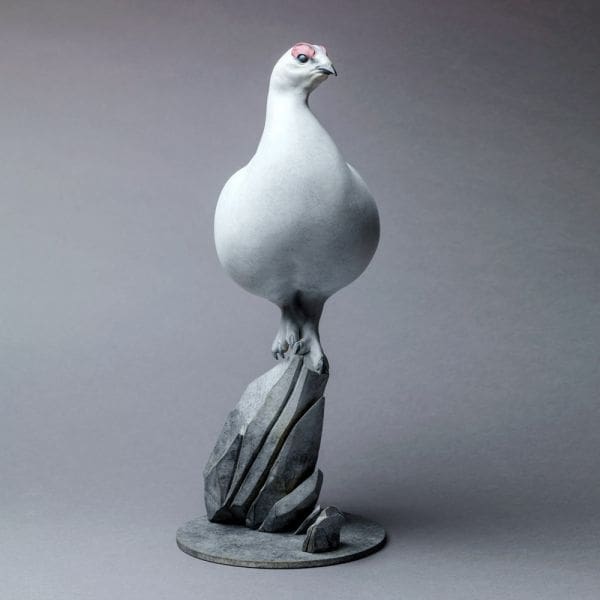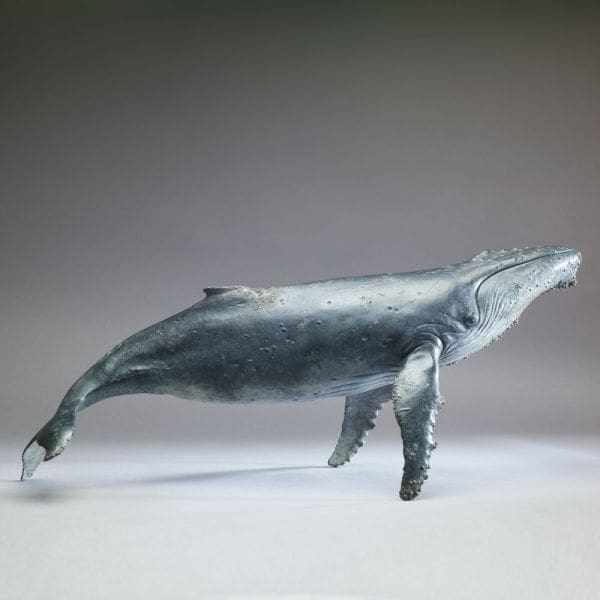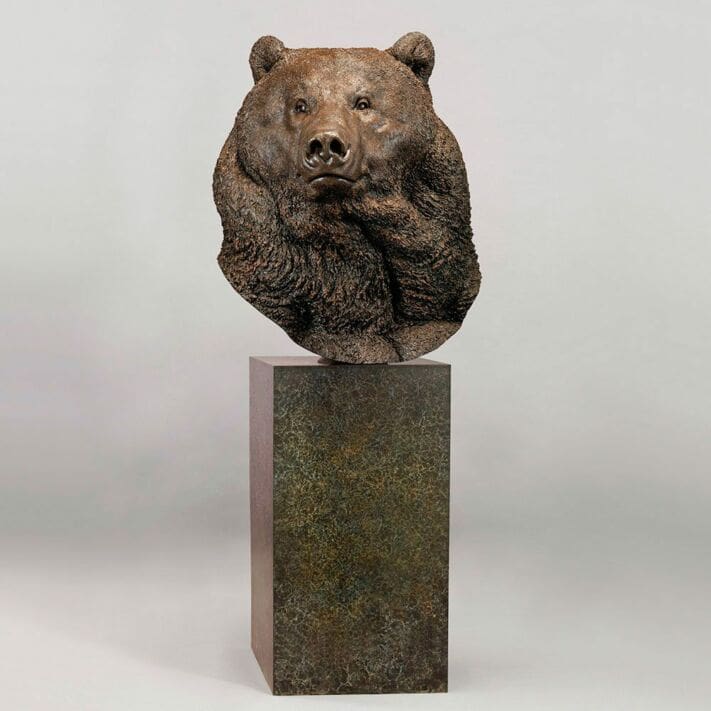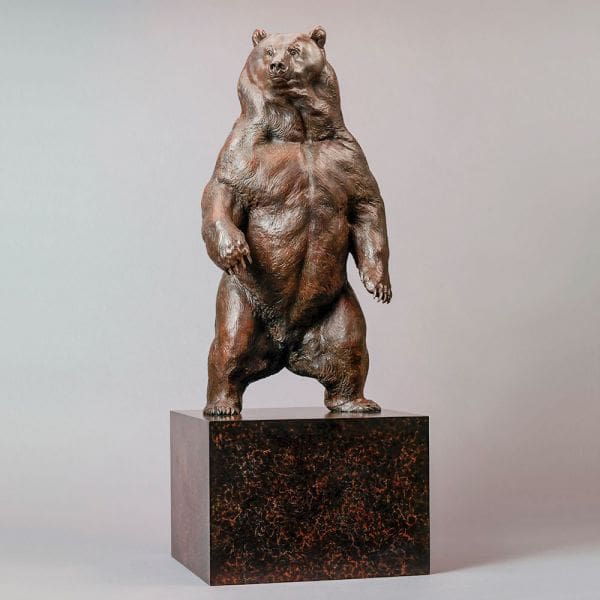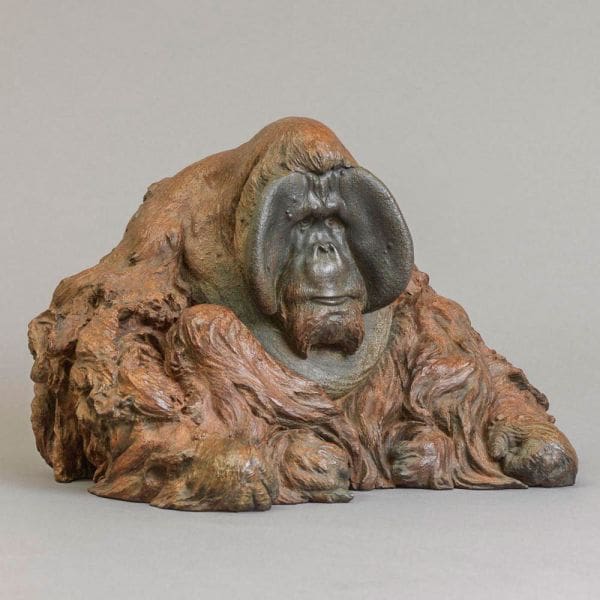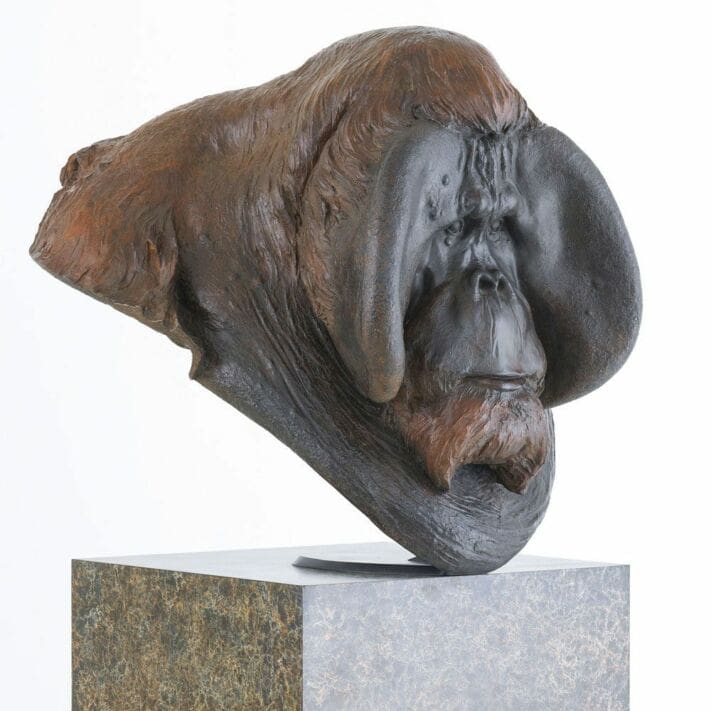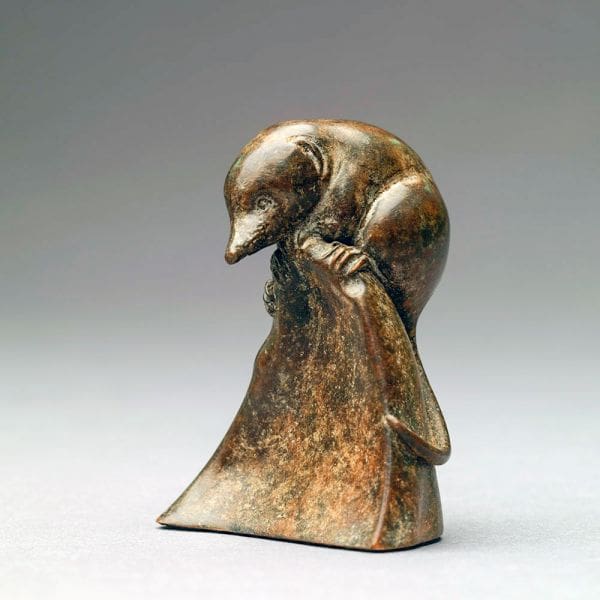
Nick Bibby’s sculptures are exquisitely observed. Rich with almost imperceptible subtleties; elevating his art from the merely good to that of a true master.
Nick Bibby’s talent, skill, experience and lifelong dedication to his craft is clearly visible in every piece he sculpts. It is truly rare to find an artist with such ability. The ‘Bibby’ sculptural style, whilst very definitely figurative, is quite unique. Fascinated by both form and detail Nick sculpts with a fluidity and energy that many admire, but few can equal. Simultaneously and apparently effortlessly, combining vivacious energy with a jewel-like attention to detail, resulting in instantly recognisable works of art. In Nick’s eyes, all his subjects are enthralling, wonderful and beautiful, and through his sculpture he strives to encapsulate that beauty and wonder for all to see. As Paul Cézanne once said of Claude Monet, “Only an eye. But what an eye!”
Nick’s sculptures are both beautiful, collectable, works of art and loving figurative portraits. With subjects ranging widely, from small to monumental, Nick’s sculptures are owned and admired by an ever growing number of Bibby Collectors worldwide.
Method:
When commencing a sculpture, Nick Bibby starts with copious reference, first constructing a supporting metal armature that often closely matches the skeleton of his subject. He rarely does working drawings. Having researched his subject, Nick builds up a fluid mental image of the piece; a mutable, three dimensional image with no need to be translated into two dimensional drawings, only to be translated back into three dimensions as the finished sculpture. Gradually adding clay or wax to the supporting armature, Nick builds up the form, making constant minor adjustments to anatomy, composition and pose, always striving for the perfect aesthetic balance between realism and art. The variety of the ever expanding ‘Bibby’ sculpture collection; birds, animals, human and mythological, is constantly driven by Nick’s hunt for knowledge, new challenges and the desire to push his limits.
Notable Highlights:
In 1999 Nick Bibby was asked to sculpt a collection of life size, state of the art, scientifically accurate, bronze portraits of extinct birds and animals, native to the islands of Mauritius, Rodrigues and Réunion, including the most famous extinction of all – the Dodo. Bones to Bronze was sculpted in close partnership with naturalists and palaeontologists from the region. The sculptures were created to raise awareness of the species lost and the species we continue to lose worldwide, whilst also raising funds to support continuing conservation work on the islands themselves, through their sale. A complete collection is on permanent exhibition on Ile aux Aigrettes, just off the coast of Mauritius, and a Bibby Dodo is also on permanent exhibition in the Ashmolean Museum, Oxford, England. This particular Dodo has even inspired a children’s book!
Nick’s wildlife subjects continue to be the mainstay of his collection, but in recent years his nationally important collection of British Champion Animals sculptures; documentary portraits of champion examples of iconic British breeds of horse, cattle, pig, sheep, dog and poultry, inspired by the collection of the same name, sculpted by Herbert Haseltine eighty years earlier, has brought further recognition and praise. Indirectly leading to a commission from the prestigious Ivy League University, Brown, to sculpt a monumental, fifteen foot, Kodiak Brown Bear (the university’s mascot) which now stands outside the Nelson Fitness Centre, Ittleson Quad, on their campus in Providence, Rhode Island. Called Indomitable, the giant bear was installed in 2013.
More recently, Nick has fulfilled commissions, for an Indian Rhino, also for Rhode Island; a nearly seven foot, heroic, classical, torso of the Greek god Apollo and a life size Orangutan, for private collectors in the UK and he is currently working on several new wildlife pieces.
Art: A Personal Perspective
I believe that every conscious being has an inbuilt aesthetic sense and ability to appreciate and be enriched by “Art” in whatever form they perceive it to be.
Any artwork, from its moment of conception, exists in a subjective, experiential, superposition, akin to the concept of superposition in quantum physics.
All art evokes a reaction within any consciousness made aware of its existence, and that reaction is unique to that consciousness, that specific artwork, and that time, place and context. No two consciousnesses will ever experience and appreciate an artwork identically, and no artwork will ever be experienced and appreciated in an identical way twice by the same consciousness. Each and every interaction is completely unique.
And until an artwork interacts with its audience, all those potential interactions and reactions exist only as an infinite number of possible future realities.
So, to sum up: “Art” is something that is experienced differently by each and every one of us, creator, viewer, expert, amateur, young, old, whoever (or in the age of AI, whatever) they may be. And that experience/interaction is always unique. Endlessly, infinitely, rewarding and different.
My art is my own; you may love it, you may hate it, you may not feel strongly either way. That is for you to discover, but regardless, my art, laid out for you here, represents my best efforts to achieve the unachievable (perfection). I invite you to dive in and enjoy the interaction!”
Nick Bibby
Sculptures by nick bibby
Credentials
Qualifications
Exhibitions
yes
Awards
Publications
The Mirror – Talented artist completes enormous 11-foot high sculpture of a grizzly bear
Belfast Telegraph – Artist finishes bear sculpture
Independent.ie – Artist finishes bear sculpture
BBC – Grizzly task for Devon sculptor Nick Bibby
Providence Daily Dose – Towering Bear Sculpture Coming To Brown
The Brown Daily Herald – U. to erect new statue by Fitness Center
Brown Alumni Magazine – Bruno Bronzed,The Mirror – Talented artist completes enormous 11-foot high sculpture of a grizzly bear
Belfast Telegraph – Artist finishes bear sculpture
Independent.ie – Artist finishes bear sculpture
BBC – Grizzly task for Devon sculptor Nick Bibby
Providence Daily Dose – Towering Bear Sculpture Coming To Brown
The Brown Daily Herald – U. to erect new statue by Fitness Center
Brown Alumni Magazine – Bruno Bronzed
Born in County Durham in 1960, Nick Bibby was a precocious talent, drawing and painting as soon as he could hold a pencil, or paintbrush. Even in those very early days, he was drawn towards work in three dimensions. His earliest childhood sculptures were made using plasticine, or whatever came to hand when the plasticine ran out, as it often did. And with his natural gift for working in three dimensions, it was an obvious progression that Nick should begin selling work in his early teens, becoming a full-time sculptor in his late teens, after leaving art college at eighteen.
Largely self taught; Nick has always pursued his own path, constantly pushing himself, seeking new challenges; ever striving towards the unachievable goal of, ‘Perfection’.
Having won numerous accolades for his early miniature figurines sculptures, Nick soon moved on to the fast-paced world of freelance sculpting and modelmaking, for the advertising industry in London in the eighties, quickly gaining a reputation for excellence and the ability to achieve the seemingly impossible.
Through it all, Nick’s abiding love of nature and the natural world shone out, and still drive his creativity today.
In 1991 Nick Bibby produced his first limited edition bronze. A life size Kingfisher, which sold out within a few months, giving him the confidence to move over full time to sculpting and exhibiting bronzes, with his first one man exhibition, at the world renowned Wildlife Art Gallery in Lavenham, Suffolk, two years later. Nick now exhibits work regularly at Sladmore Contemporary, Mayfair, London, and Gladwell & Patterson, Knightsbridge, as well as several other galleries in the UK. In addition, Nick’s works have been exhibited at The Royal Academy of Art, The Mall Galleries, The Pinacoteca Giovanni e Marella Agnelli, Turin, Leigh Yawkey Woodson Museum of Art, Wisconsin, Sigurjon Olafsson Museum, Reykjavik and the Society of Portrait Sculptors, to name but a few.
Nick Bibby has a global following including, major collectors, international governments and famous artists.
His sculptures range from monumental to miniature, but all show an exquisite attention to detail.
Nick Bibby now lives and sculpts in Devon, a place he loves, and which provides him with constant inspiration.
LIMBLESS WONDERS
When the Venus de Milo was unearthed in 1820 on the Greek island of Milos, it was almost immediately recognised as a paragon of feminine beauty. A pity about the arms, of course, giving rise to endless conjecture about what, precisely, the lady (goddess, presumably) was doing: weaving, serving, worshipping or offering a prize? But was it really a pity that the arms had disappeared? Somehow their absence, taken with the perfection of form in what remained, in some ways set off, or even enhanced, the abstract beauty of the figure and face. By an historical accident, the sculpture, dating from the second century BC, was to represent a sculptural tradition according to which the part, cunningly isolated, might prove in some ways more expressive than the whole.
To this tradition, celebrating if you like the power of the close-up, Nick Bibby`s heroic torsos unmistakably belong. He even signals the classical connections by labelling the male torso Apollo and the female Artemis, which indicates that he is clearly aware of the tradition into which he is inscribing himself. We call it Classical, but it is very doubtful whether the sculptures of Praxiteles or Alexandros of Antioch, the apparent creator of the Venus de Milo, were ever partial figures when they left the artists` studio. Indeed, the idea of deliberately producing a partial figure sculpture seems to be a relatively modern one. Significantly, the Venus de Milo was discovered at the height of the Romantic era, just four years before Byron died fighting the cause of an independent Greece at Missolonghi. And it is easy to associate the rise of deliberately fragmentary sculpture with the Romantic craze for ruins.
Busts are one thing, associated particularly with funerary sculpture ever since ancient Rome. But armless, legless, and, perhaps especially, headless torsos, male and female, are really a Romantic, Nineteenth-Century invention. Essentially late-Romantic at that. The last of the self-consciously Classical sculptors, such as Canova, Flaxman and Thorwaldsson, would not have dreamt of deliberately presenting a fragmentary or unfinished-appearing sculpture to public view as an achieved work in its own right. Even later, more Romanticism-tinged figures like Carpeaux might make such works only as a preliminary study or transitional piece, to remain hidden from prying eyes in the studio. It is not until we come to Rodin that we encounter a sculptor who glories in the idea and constantly turns to it in his public art.
There are two aspects of Rodin that contribute to this revolutionary attitude: that he was almost exclusively a modeller, a master of bronze rather than of stone, and that he lived very consciously in the artistic world of the Impressionist painters, and shared their fascination with the transitory, the evanescent. He wanted to achieve in the sometimes obstructively solid medium of sculpture a sense of panta rei (all things flow), so that his figures, like the humans they represent, seem to be constantly in a state of flux, moving from place to place and evolving in time. Sometimes Rodin would have the "excuse" that his small individual pieces were all really studies for the great and complex works like The Gate of Hell, with its myriad souls in torture. This was frequently true enough, but still he sold the fragmentary maquettes as self-sufficient works of art.
Through Rodin`s recognition as the greatest sculptor of his generation, his views on the nature and possibilities of sculpture became acceptable and then accepted. Since Nick Bibby, unlike, say, Henry Moore, a carver to the roots of his being, is also primarily a modeller whose favoured medium is bronze, it has been impossible for him to remain totally outside Rodin`s sphere of influence. This is particularly noticeable in his human figures and some, but not all, of his animal figures. There it depends on the animal: Rodin`s Impressionism is appropriate to the soft and gentle outlines of a bloodhound, but would hardly do for a monumental figure of a Kodiak bear or a champion carthorse. But wonderful though these are, his relatively few human figures remain among his finest achievements.
The two torsos may not be quite monumental, but they are certainly heroic. As indeed they should be, if they are associated, however loosely, with classical gods and goddesses. Paradoxically, they are both intensely realistic and unmistakably ideal. Among the skills required of a sculptor working in a broadly realistic context is the ability to choose exactly the right model. I do not know where Bibby found his models for these two torsos, but it looks as though they came as close to physical perfection as even a god could desire.The structure of bone and muscle beneath the skin is beautifully (and accurately) rendered, by a master hand, as capable as Rodin of framing their fearful symmetry.
John Russell Taylor
Author and Art Critic
"Bones to Bronze" Extinct species of Mauritius, Rodrigues & Réunion, Iles Aux Aigrettes, Mauritius
"Indomitable" Monumental Kodiak Brown Bear: Brown University, Rhode Island
Life Size Emperor Penguin: The Wilson Museum, Cheltenham




